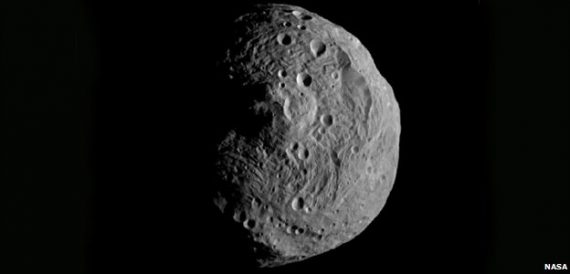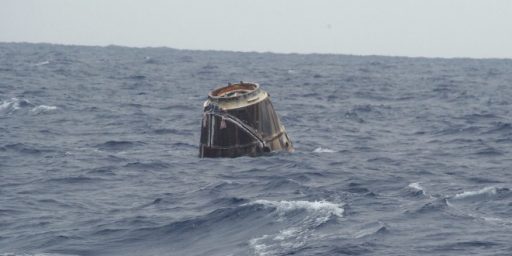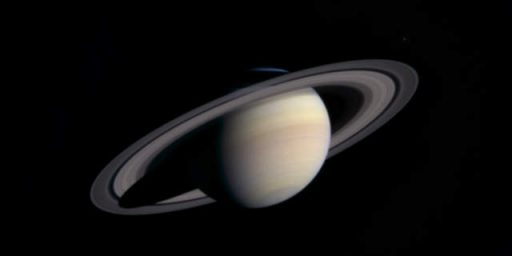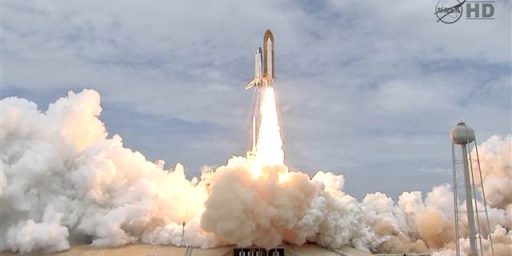NASA Dawn Returns Images Of Vesta Or, The Space Program Is Not Dead
Reports of the death of the space program are greatly exaggerated.
With the return of the Shuttle Atlantis a lot of people seem to be writing obituaries for the space program. While it’s true that it will be 3-4 years before American astronauts are back in orbit on American rockets (a delay roughly equivalent to the gap between the last Apollo mission and the first Shuttle launch), that doesn’t mean we’re confining ourselves to Earth. While Altantis was preparing for its return to earth, a probe called Dawn was entering orbit of an asteroid named Vesta:
Nasa’s Dawn spacecraft has returned some remarkable new imagery of the asteroid Vesta, now that it is safely in orbit around the 530km-wide rock.
The pictures reveal the ancient body’s craters, slopes and grooves in detail that is far beyond the vision of Earth-bound telescopes, including Hubble.
Dawn scientists will have a busy year interpreting the asteroid’s features.
They will be looking for some fresh insight on how such objects came into being 4.6 billion years ago.
It is often said the asteroids, which dominate a region of space between Mars and Jupiter, are the rubble that was left over after the planets proper had formed.
“We are beginning the study of arguably the oldest extant primordial surface in the Solar System,” said Dawn’s principal investigator Christopher Russell from the University of California, Los Angeles.
“This region of space has been ignored for far too long. So far, the images received to date reveal a complex surface that seems to have preserved some of the earliest events in Vesta’s history, as well as logging the onslaught that Vesta has suffered in the intervening eons.”
Dawn will spend a year surveying Vesta before moving on to bigger and better things:
Once it has completed its work at Vesta, the probe will move on to the even bigger rock, Ceres. With a diameter of roughly 950km, this world has a much more rounded shape and is classed as a “dwarf planet”, the same designation now ascribed to Pluto.
Ceres is actually classified as a minor planet and, unlike Vesta and other asteroids, has a core-mantle configuration similar to that of Earth and the other interior planets. It’s expected that exploring both bodies will add greatly to our knowledge about the formation of the Solar System and its early life, and may also help to provide evidence to determine how the Asteroid Belt came to be formed.
Dawn isn’t the only NASA mission that will be launched in the coming years. In August, Juno will be launched on a mission to Jupiter with an expected arrival date in August 2016. Later in the year, the Mars Science Laboratory, which includes a new Mars Rover named Curiosity, will head toward the red planet with an expected arrival date in August 2012 and is expected to operate for at least one Martian year (slightly under two Earth years). In February 2012, the Nuclear Spectroscopic Telescope Array a space-based X-ray telescope, will be launched as part of the continuing mission to explore deep space and the origins of the universe. Sometime in 2017-2018, the James Webb Space Telescope, a space-based infrared telescope intended to replace the Hubble Space Telescope, will be launched and begin its mission. While this is going on, private entities like Space-X will be developing the commercial side of orbital launch vehicles, and NASA will be working on what is currently referred to as the Shuttle-Derived Heavy Lift Launch Vehicle, a next-generation heavy-lift rocket designed to get manned American spacecraft into orbit, and beyond. In the meantime three U.S. launched probes — Pioneer 10, Voyager 1 and Voyager 2 — have left the confines of the Solar System for the vast unknown beyond.
In other words, the space program did not die today. Manned launches may be on hiatus while we wait for the development and perfection of new launch technologies, but the space program is alive and well.
There’s one final thing about the Dawn mission that’s worth noting. The article I quote from at the top of this post comes from the BBC and I chose it because it was the most complete one I could find online. The Washington Post merely has a short blog-type article about the mission. The New York Times doesn’t seem to have written about the mission at all. CNN has an article about it on Friday. MSNBC did a story on Saturday. And there was no mention of the Dawn mission during the coverage of this morning’s shuttle landing.
If you’re interested in the Dawn mission, you can follow it at NASA’s page for the mission. You can also follow the Dawn mission on Facebook and Twitter







It’s also worth noting the Mars Rover, Opportunity, is still operational today as well, years beyond it’s predicted life.
http://marsrover.nasa.gov/home/
I loved the local media coverage of the shuttle landing today. Between 6 and 7 this morning we heard reporters citing the lost jobs due to the end of the shuttle program being 7,000, 8,000, and 9,000. In the case of one news station, one reporter said 8,000, and another 9,000.
I’m not so sure about the future of the James Webb.
It pains me to admit that unmanned exploration of our solar system will probably be the best route for NASA during my lifetime.
The Webb telescope would provide great science but as the cost of eating most of NASA’s science budget. The location its going to and design makes me nervous too because its not built to be serviced like Hubble. It also has to unfold sun shields and mirrors like an origami figure. Too much to go wrong I fear…
If it ever happens, and if it does it won’t be for a very long time, Ceres or Vesta would be good places for a deep space station. Plenty of material to use to protect yourself from radiation, potentially large amounts of water, and you don’t land so much as dock with them.
We won’t see it in our lifetimes which is a pity.
It’s not going to be the same, if it happens at all. Face it at a time when there is a very ral chance that americans will stop getting social seurity checks and when emplyment checks have already run out and people inexplicably demand austerity in the middle of a recession (I guess to make it that much more recession-y) sending manned missions to space is a VERY low hanging fruit to cut. It’s dangerous and expesive and so long as we’re just putting satellites in orbit and repairing them there’s no need when unmanned vehicles can do the same job far more cheaply.
Barring some new propulsion technology that’s vastly more efficient than rockets, or another “we do this to celebrate our own greatness” sort of spirit, the age of man in space is closed for the forseeable future. It’ll end with a whimper but it’ll end.
This is just a flat out lie.
At the very worst..write off the trust fund, continuing high unemployment, keep everything else the same…in 50 years or so Social Security checks will fall to only be 75% of promised benefits.
And that is the worst case scenario.
Keeping the manned program going has been enormously expensive. The space shuttle was a very inefficient way to lift a kilo of mass into orbit. The tech transfers we get from NASA would happen from manned or unmanned programs. In fact, I think the unmanned program has the best potential for tech transfer in the form of robotics and AI. And for the cost of the shuttle program you can do much more unmanned missions.
But I fear NASA is going away any way. Given what is coming with the budget it will be hard to justify NASA funding. Maybe if they convert it into something like a high tech land grant college system where NASA sits at the top of a research pyramid and the base is public Universities which will do a lot of the basic research. In order to survive NASA will need to get funding from some source outside the federal budget.
@Jib: Yes, the US must chose between an empire on Earth or an expanding empire in space.
The private sector has been working in the background for years, and appears to be ready to take off where NASA has ended. Space travel and exploration will also most likely be done more quickly and with less cost, as well, under the guidance of the private sector.
Space Exploration: 9 Private Sector Companies Ready to Take Off
@jan: The customer is still going to be the customer and if the customer has no money there will still be no space program. I don’t see how this is going to change anything. NASA up to this point has been the customer and most of the design and development was done by the private sector.
@Ron Beasley:
There is simply more innovation energy in the private sector, IMO, which will override the reluctance of money being spent in the space program under NASA. You’re right that NASA has been a customer of the private sector. Now, the private sector will be involved with private sector customers, sans the government bureaucracy.
Private space race
It would be the same thing with the post office, which is faltering under the burden of it’s own sluggish bureaucratic mismanagement. Privatize it and it would be less costly and run more efficiently. The same with public education, trains etc. Centralized planning creates a labyrinth of red tape and runaway costs that are curtailed and controlled better under the oversights of a smaller business model.
This is side bar from the space program, however as an anecdotal recollection of government vs. private efforts, my husband and I were on a school committee to reconstruct our school’s auditorium stage. My husband, being in construction, detailed what he thought would be reasonable labor/material costs. But, since everything has to be bid out though the state the eventual bid was many times greater than my husband’s calculations. It was an eye-opener in comparing and contrasting how wasteful government really is when planning and funding projects.
@jan: I disagree Jan – there is little or no money to be made in the foreseeable future and possibly ever. Taking a few millionaires on sub-orbital flights or even launching commercial satellites is not space exploration. There is no money to be made going to the Moon or Mars – no money to be made launching unmanned space craft into deep space and that’s exploration.
Let’s face it, if any country goes to Mars, it will be China.
@Ron Beasley:
Obviously, Ron, anything you and I may say is pure speculation based upon information we’ve heard and our own given political philosophy.
I have heard, though, people from the private industry being interviewed in the past, and were quite impressed with their fortitude, ideas and sheer enthusiasm for venturing into the frontiers of space. And, while millionaires may be the initial humans launched to achieve capital, visibility, and credibility I think there is more to follow with goals being exploration and even settlements in the near and distant future.
I have found men’s minds should not be underestimated, especially when unshackled from the confines of government intervention.
@ponce:
China is planting their flag on the sea floor in order to claim prized minerals there, and making attempts to go to the Moon and Mars in order to claim superiority in the world — I would imagine that would include weaponizing and colonizing them.
In the meantime, the United States is spending it’s money on high speed trains linking up one dead end town to another — whoopeee! Far reaching thinking? I don’t think so.
@jan: Funny you should mention high speed trains considering China has already completed several of their high speed train projects…
Jan, tell me, where is the money? Show me the money… Show me the money…SHOW ME THE MONEY….
I am waiting.
My point is only that w/o gov’t, there is no profit in space…. yet. So to think that there will be space exploration w/o gov’t, is to believe in fool’s gold.
The private sector can’t even pay for their own spaceport.
Jan,
The Chinese are actually linking their cities with high speed rail, America is just talking about doing it.
Great countries can do things like that.
Not to worry, America is simply easing into the comfortable former superpower role that Britain has been playing for the past 60 years.
Not a bad life really.
@ponce:
High speed trains is a low priorty when looking at more pressing issues we now face.
What pressing needs?
We are(for a little while longer) the most prosperous nation in the history of the world.
The only real problem we face is one of our major political parties has been infiltrated and taken over by fear mongering hucksters.